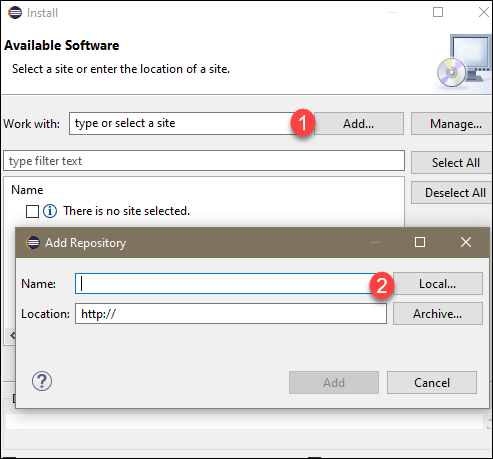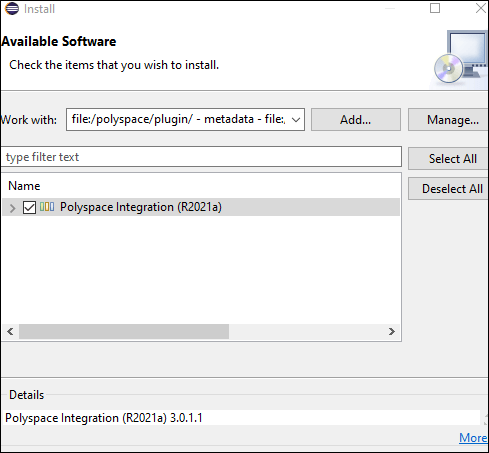在 Eclipse 中安装 Polyspace as You Code 插件
在基于 Eclipse™ 的 IDE 中使用 Polyspace® as You Code 插件,您可以对当前正在查看的文件运行 Polyspace 并查看分析结果,例如 Bug 和编码标准违规。您必须安装 Polyspace as You Code 分析引擎才能运行分析。使用此插件,您可以从 Eclipse 指向此分析引擎并显示由 Polyspace 分析生成的结果。
注意
如果您在 Linux® 上安装 Polyspace as You Code Eclipse 插件,请参阅在 Linux 上为受支持的 Java 版本配置 Eclipse。
可以通过以下两种方式之一安装此插件:
运行 Polyspace as You Code 安装程序时,选择相应的选项来安装此插件。安装程序将安装 Polyspace as You Code 分析引擎和此插件。
如果您在运行 Polyspace as You Code 安装程序时仅安装分析引擎,可在以后再使用
polyspaceroot\polyspace\plugin\eclipse_paycpolyspacerootC:\Program Files\Polyspace as You Code\R2025b。
本主题其余部分的内容将介绍第二种方法,即在运行安装程序时跳过此插件的安装并在以后使用 polyspaceroot\polyspace\plugin\eclipse_payc
Polyspace as You Code Eclipse 插件与用于 Eclipse 的 Polyspace 桌面端插件不兼容。在安装 Polyspace as You Code Eclipse 插件之前,请先卸载桌面端插件。
交互式安装
要以交互方式安装此插件,请执行以下操作:
在 Eclipse IDE 中,选择帮助 > 安装新软件。
在安装窗口中,点击添加,然后点击添加存储库弹出窗口中的本地。

导航到
polyspaceroot\polyspace\plugin\eclipse_payc确保已选择 Polyspace 插件,然后点击下一步并按照提示完成安装。

要卸载此插件,请转至帮助 > 关于 Eclipse IDE。在关于 Eclipse IDE 窗口中,点击安装详细信息,在安装的软件选项卡上选择 Polyspace 插件,然后点击卸载并按照提示操作。
命令行安装
要安装此插件,请打开一个终端,导航到您的 Eclipse 安装文件夹(例如 C:\Program Files\eclipse)并输入以下命令:
eclipsec.exe -application org.eclipse.equinox.p2.director ^ -repository file:"/polyspaceroot/polyspace/plugin/eclipse_payc/" ^ -installIU com.polyspace.eclipse.feature -nosplash
polyspacerootC:/Program Files/Polyspace as You Code。指定 -repository 路径时必须使用正斜杠“/”。要卸载此插件,请输入以下命令:
eclipsec.exe -application org.eclipse.equinox.p2.director ^ -uninstallIU com.polyspace.eclipse.feature -nosplash
在 Linux 上为受支持的 Java 版本配置 Eclipse
Polyspace as You Code Eclipse 插件不支持 Java® 版本 13 及更高版本。如果您的 Eclipse IDE 使用的是不受支持的 Java 版本,则在启动 IDE 时会看到一条错误消息。
要配置您的 IDE 以使用受支持的 Java 版本,请执行以下操作:
转至 https://jdk.java.net/archive/,下载适用于 Linux 的 OpenJDK 版本 12 GA(编译版本 12+33),然后右键点击已下载的 TAR 文件来提取其内容。
或者,在命令行中输入以下命令:
wget https://download.java.net/java/GA/jdk12/33/GPL/openjdk-12_linux-x64_bin.tar.gz tar xzvf openjdk-12_linux-x64_bin.tar.gz
在文本编辑器中打开文件
eclipseRoot/eclipse.ini-vm行下方的路径替换为您在步骤 1 中下载的 openJDK 安装的bin文件夹的路径。eclipseRoot文件夹是您的 Eclipse IDE 安装文件夹。例如,如果您将步骤 1 中下载的文件提取到文件夹
/local/tools中,则eclipse.ini文件中-vm行前后的部分将如下所示:--launcher.defaultAction openFile --launcher.appendVmargs -vm /local/tools/jdk-12/bin
重新启动 IDE 以应用更改。